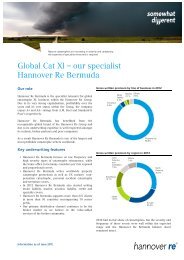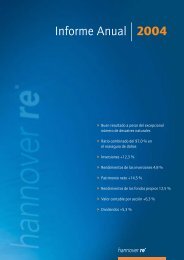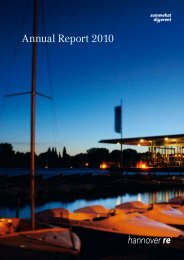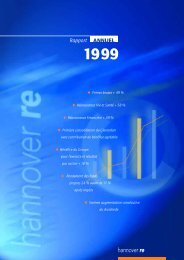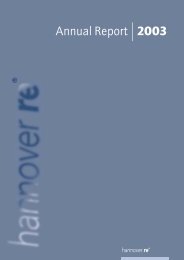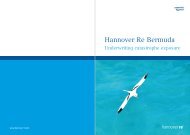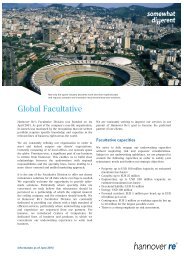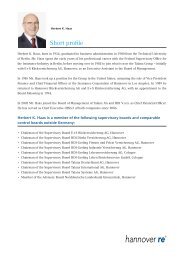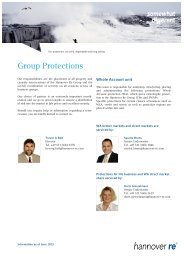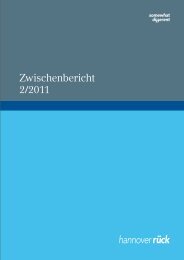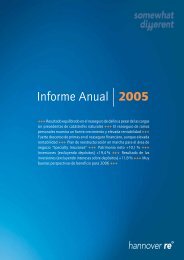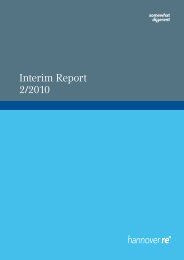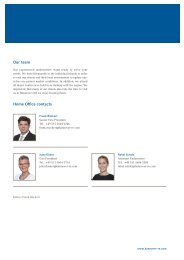Annual Report 2003 - Hannover Re
Annual Report 2003 - Hannover Re
Annual Report 2003 - Hannover Re
You also want an ePaper? Increase the reach of your titles
YUMPU automatically turns print PDFs into web optimized ePapers that Google loves.
Notes<br />
other notes<br />
Outstanding capital commitments with respect to special investments exist in the amount of<br />
EUR 62.8 million for E+S Rückversicherungs-AG and EUR 115.4 million for <strong>Hannover</strong> <strong>Re</strong>. These involve<br />
primarily private equity funds and venture capital firms in the form of private limited companies.<br />
Within the scope of a novation agreement regarding a life insurance contract we assumed contingent<br />
reinsurance commitments with respect to due date and amount estimated at EUR 25.7 million<br />
as at the balance sheet date.<br />
7.3 Long-term commitments<br />
Several Group companies are members of the German aviation pool, the association for the reinsurance<br />
of pharmaceutical risks and the association for the insurance of German nuclear reactors. In the<br />
event of one of the other pool members failing to meet its liabilities, an obligation exists to take over<br />
such other member’s share within the framework of the quota participation.<br />
7.4 Derivative financial instruments<br />
The accounting of the "Modco" and "CFW" reinsurance treaties, under which security deposits are<br />
held by the ceding companies and payments rendered on the basis of the income from certain securities<br />
of the ceding company, must comply with the standards of SFAS 133 DIG B 36. The derivatives embedded<br />
in such host contracts are to be reported separately from the underlying reinsurance arrangements<br />
at fair value (cf. section 1 "General accounting principles").<br />
A small number of treaties in life and health reinsurance meet criteria which require the application<br />
of SFAS 133 DIG B 36. Under these treaties the interest-rate risk elements are clearly and closely<br />
linked with the underlying reinsurance arrangements. Embedded derivatives consequently result solely<br />
from the credit risk of the underlying securities portfolio.<br />
<strong>Hannover</strong> <strong>Re</strong> calculates the fair value of the embedded derivatives using the market information<br />
available on the valuation date on the basis of a "credit spread" method. Under this method the derivative<br />
is valued at zero on the date when the contract is concluded and its value then fluctuates over<br />
time according to changes in the credit spread of the securities.<br />
The application of DIG B 36 had no significant impact on the consolidated financial statement in<br />
the financial year. The fair values of the embedded derivatives were recognised in the investments as<br />
at the balance sheet date and to this extent increased the investment income. The pre-tax effect on the<br />
investment income amounted to altogether EUR 3.3 million as at the balance sheet date. Of this<br />
amount, EUR 2.8 million before tax was attributable to the cumulative adjustment based on first-time<br />
application of the standard as at 1 October <strong>2003</strong> with tax expenditure of EUR 0.5 million, and the investment<br />
income after tax was therefore increased by EUR 2.3 million under the first-time application.<br />
In the course of the fourth quarter the fair value of the embedded derivatives further increased by a total<br />
of EUR 0.5 million before tax.<br />
Since <strong>Hannover</strong> <strong>Re</strong> concludes reinsurance transactions worldwide in numerous international currencies,<br />
the Group is exposed to currency fluctuations.<br />
<strong>Hannover</strong> <strong>Re</strong> uses derivative financial instruments to control these currency exposures as well as<br />
interest rate risks and market price risks arising out of the use of financial instruments (e.g. investments<br />
in variable-yield and fixed-income securities). Derivative financial instruments are used within the <strong>Hannover</strong><br />
<strong>Re</strong> Group solely for hedging purposes.<br />
120



